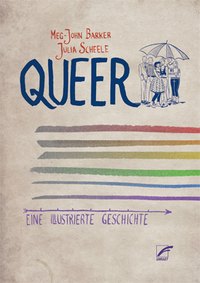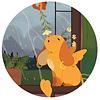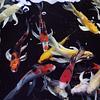Take a photo of a barcode or cover
1.06k reviews for:
Queer: Eine illustrierte Geschichte
Jennifer Sophia Theodor, Meg-John Barker, Julia Scheele
1.06k reviews for:
Queer: Eine illustrierte Geschichte
Jennifer Sophia Theodor, Meg-John Barker, Julia Scheele
4.5 stars. This book was different than I expected it to be-- I thought it was about the history of queer people and/or the queer community. Actually, it's about the history of the academic field of Queer Theory. This isn't a bad thing! I was just surprised, and I feel like the title could have been made to be less misleading.
The authors go to extreme lengths to show that there are many different approaches to queer theory, and valid criticisms to be made against it. I thought this book was a really informative overview of the big ideas/thinkers of this discipline and its precursors. However, there is a lot that they didn't quite cover that is instead jammed into a few pages in the back of the book, like fat activism, asexuality (no discussion at all of the difference between sexual and romantic attraction), and disability. Transgender theories get a bit more attention, and race/intersectional theories a bit more than that. However, it is also understandable that it would be a tall order to adequately, exhaustively, represent all people and communities in one book, especially a graphic one, and the authors did include suggested further readings in these areas. It's worth noting too, though, that there is hardly a single mention of religious identities and the way they interact with queerness, other than a shout-out to Buddhism for recognizing non-binary identities (as if that's the only religion throughout time to ever do so?).
Overall, I think this is a fairly even-handed look at where queer theory has been and where it is today; its triumphs and pitfalls. I see some TERFs in the reviews peeved over the author's use of the term "TERFs", which is (in my opinion) frankly a huge selling point for the book. The graphics were clear and well-done, and often served to further clarify an idea or some confusing terminology. There is a lot packed into this (relatively short) book, and a lot of thought-provoking ideas to ruminate on. I think I might need to own a copy so that I can refer to it in the future, or take the time to focus on and further research specific ideas/writers. I do wish the book had been better organized into chapters and sections, or had some sort of index at the back that would make it easier to find certain pages. Still, I think Queer: A Graphic History is well worth the time it takes to read, even if you don't agree with everything included or excluded from it.
Queer theory, like all of us, has no fixed identity and multiple - contradictory - origin stories, rather than any one linear narrative. Like us it's plural rather than singular, in flux rather that static.
The authors go to extreme lengths to show that there are many different approaches to queer theory, and valid criticisms to be made against it. I thought this book was a really informative overview of the big ideas/thinkers of this discipline and its precursors. However, there is a lot that they didn't quite cover that is instead jammed into a few pages in the back of the book, like fat activism, asexuality (no discussion at all of the difference between sexual and romantic attraction), and disability. Transgender theories get a bit more attention, and race/intersectional theories a bit more than that. However, it is also understandable that it would be a tall order to adequately, exhaustively, represent all people and communities in one book, especially a graphic one, and the authors did include suggested further readings in these areas. It's worth noting too, though, that there is hardly a single mention of religious identities and the way they interact with queerness, other than a shout-out to Buddhism for recognizing non-binary identities (as if that's the only religion throughout time to ever do so?).
[P]erhaps queer theory needs to move away from dismissing any form of identity category, to considering both what the categories enable for people and what they close down.
Overall, I think this is a fairly even-handed look at where queer theory has been and where it is today; its triumphs and pitfalls. I see some TERFs in the reviews peeved over the author's use of the term "TERFs", which is (in my opinion) frankly a huge selling point for the book. The graphics were clear and well-done, and often served to further clarify an idea or some confusing terminology. There is a lot packed into this (relatively short) book, and a lot of thought-provoking ideas to ruminate on. I think I might need to own a copy so that I can refer to it in the future, or take the time to focus on and further research specific ideas/writers. I do wish the book had been better organized into chapters and sections, or had some sort of index at the back that would make it easier to find certain pages. Still, I think Queer: A Graphic History is well worth the time it takes to read, even if you don't agree with everything included or excluded from it.
informative
reflective
medium-paced
Really informative, covered a broad range of subtopics & ways of thinking about queer theory.
First of all, this should be called Queer: a graphic theory not 'history'.
I’m not sure how I feel about this book, because I felt like I read an extensive Wikipedia article; meaning, that all the information was quite short but the sources were helpful in case you want to know more about the theories.
I do want to give credit to the illustrator because it made it more bearable but I wouldn’t recommend this book to anyone who wants to know about queer activism or queer identity or even the fact that not all LGBTQ+ folks want to use the word queer to identify themselves. I must admit I am new to some subjects but this wasn’t as helpful as I thought it would be.
I’m not sure how I feel about this book, because I felt like I read an extensive Wikipedia article; meaning, that all the information was quite short but the sources were helpful in case you want to know more about the theories.
I do want to give credit to the illustrator because it made it more bearable but I wouldn’t recommend this book to anyone who wants to know about queer activism or queer identity or even the fact that not all LGBTQ+ folks want to use the word queer to identify themselves. I must admit I am new to some subjects but this wasn’t as helpful as I thought it would be.
challenging
informative
fast-paced
challenging
emotional
hopeful
informative
inspiring
lighthearted
fast-paced
informative
slow-paced
cant read on mobile formatting is shite
Probably one of the only somewhat accessible ways to understand queer theory. There is a lot to think about and digest in this book, and it is written in an approachable way. However, the concepts will be difficult. Whether you agree with the principle or not, it is an interesting way to learn about one form of thinking.
informative
fast-paced
informative
inspiring
reflective
medium-paced





